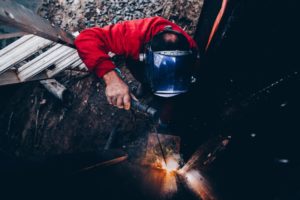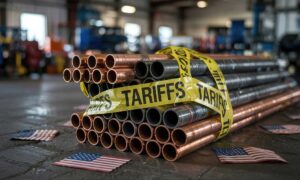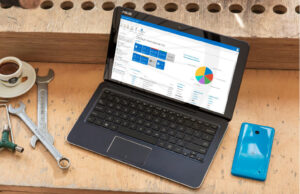
The manufacturing industry is powered by state-of-the-art software that drives innovation, facilitates automation, and gives companies of all sizes the means they need to stay profitable and relevant in one of the world’s most lucrative and competitive sectors.
Companies in the metal fabrication sector, for instance, use an array of specialist programs, including plate processor software, multi-line processor software, cut-to-length software, and coil processor software. But all of these things can be rolled into one comprehensive suite. That’s where enterprise resource planning (ERP) and material requirement planning (MRP) enter the picture.
So, what exactly are ERP and MRP, how do these two approaches differ, and which one is best for your company?
What is MRP?
MRP systems help manufacturers and distributors identify which materials are needed for the production process and where they would be best utilized. Companies can use these systems to predict when there will be demand, thus ensuring they are properly prepared with a fully stocked inventory.
MRP was created out of necessity. For a long time, manufacturers focused on a mass-production model. Most parts were made in-house, and what couldn’t be produced could be ordered in bulk from local suppliers. These days, however, consumers demand customization, and increased competition across the industry means that the personalized approach become the norm.
To keep pace with these changes, companies increasingly turned to MRP systems. These systems made it easier to manage multiple aspects of the business, allowing manufacturers and distributors to offer increased customization and oversee various functions, including:
- Complete inventory management
- Easier supply chain management
- Insights into current and future stock levels
- Schedule tracking
Key Features of MRP
- Prevents productivity loss and minimizes downtime
- Makes sure the manufacturer has enough stock to cover increased demand
- Inventory levels are maintained across the board, from the raw materials needed for the manufacturing process to the end product that’s eventually shipped to the consumer
- Assists with a host of manufacturing processes
- Manages purchases and sales orders
Benefits of MRP
- Control inventory and prevent overspending and stockpiling
- Gain detailed insights into the production process
- Find problems in the sales and order process
- Manage all manufacturing resources effectively and efficiently
- Use data to optimize production
What is ERP?
MRP software has advanced significantly over the years, incorporating more features and functions to cater to the growing needs of manufacturers. Many of these features are present in systems known as MRP II, but ERP expands on these features even further.
ERP systems incorporate various aspects of the business and are used throughout the manufacturing sector, including steel fabrication, metal framing, and plate processing. ERP suites include elements such as:
- Plate processor software
- Financing and accounting programs
- Sheeting and leveling software
- Metal framing software
- Order processing
- Supply chain management
- Client management solutions
- Steel nesting software
All of these elements communicate with one another to better serve the business and provide a high level of organization and automation.
An ERP system can be installed on the premises or activated through the cloud, with the latter option reducing start-up and maintenance costs, making it more accessible for smaller manufacturers operating on a tight budget.
Key Features of ERP
- Complete integration of software solutions
- Everything is connected to the same database
- Operations occur in real-time
- The same user interface is used across the industry
- Support for various applications and additional components
Benefits of ERP
- A single source of information across the company
- Cloud-based solutions negate the need for expensive servers and on-site systems
- Gain real-time insights into an array of operations
- Integrate various components into a single suite
- Saves time and money for all departments
What is the Difference Between ERP and MRP?
ERP is a complete turnkey solution that handles many aspects of the organization’s day-to-day management. Multiple software suites and components are integrated into one all-encompassing solution, making life easier for the company and potentially reducing costs and lead time.
MRP deals more with inventory management within the manufacturing sector. It’s not as broad, but it can be just as beneficial. It can also work alongside ERP applications, offering the best of both worlds and improving efficiency across every facet of the company.
ERP or MRP in the Metal Fabrication Industry?
ERP and MRP are two separate systems, but they can work together and serve the organization. You can integrate both solutions, but if ERP provides more benefits, covers more areas, and can be used by everyone in the company, why would you even need MRP?
Well, while it always makes sense to consider ERP, there are also times when it pays to add an MRP system:
- You want to dial in your inventory management, reducing waste and ensuring you’re prepared for future demand.
- You want to protect your profit margins by avoiding unnecessary purchases and ensuring you’re not stockpiling inventory without really knowing if it will be required.
- You lack the current functionality needed to organize and manage inventory and need a little more refinement in this area.
Fortunately, some of the best modern ERP solutions designed for the manufacturing industry also have MRP functionality. Such is the case with RealSTEEL, a suite that was designed specifically for the manufacturing sector and is already being used by countless successful metal fabrication businesses.
Summary: ERP or MRP for Steel Fabrication and Metal Framing Businesses
In a large organization, all departments can use the ERP system and benefit from its features. However, MRP serves only those with ties to manufacturing operations.
You don’t need to choose one or the other, though. You can incorporate both of these systems into your business. To discover how these software solutions can make your business more efficient, profitable, and future- proof, contact us to learn more about RealSTEEL.
RealSTEEL is already trusted by companies across the manufacturing industry, including metal service centers, metal fabrication, metal framing, plate processing, and coil processing. It is a comprehensive, state-of-the-art business management solution that easily integrates into your existing infrastructure and can adapt to suit the needs of any business, regardless of specialty or size.




